Trumpeter Swans
Swans are big. Indeed, the Trumpeter Swan is not only the largest bird on the Lake, it is the largest waterfowl anywhere. Yet although large, swans aren’t frequent; they are seen here only during spring and fall migrations. So, while locals can see them for perhaps a month or so each year, the cottage crowd misses out—in the summer, swans are in the Arctic breeding.
Two species of swans visit the Lake: Trumpeters and Tundras. The Tundra Swan was the only frequent visitor in the late twentieth century at which time the Trumpeter was listed as rare—lucky to see. That has changed: each species is now easy to find foraging in the shallows of the lake during migration.
These two species of swans differ in many ways—size, voice, breading range—yet when seen from a distance, they are difficult to distinguish. Many of the identifying marks, while characteristic of a species, may not be unique to it, so telling which is which is often not easy.
Yet, all is not lost: the head often reveals subtle differences, usually around the beak and eyes. These are discussed in the picture captions where an attempt has been made to follow Sibley’s guidelines. In addition, this site presents its own pictorial guide to Swan Identification. Curiously, one of the most striking and variable features of these swans, the colour of the (adult’s) head and neck has nothing to do with the species. Naturally white, these feathers become rust stained if a swan has been feeding in iron–rich waters and mud.
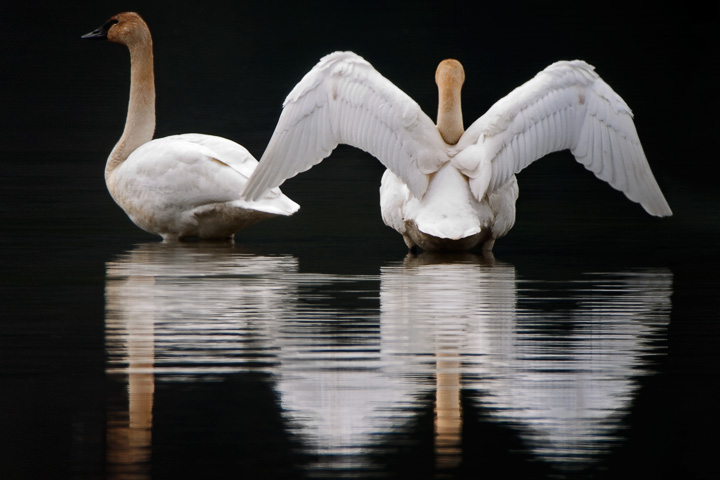 Trumpeter Swans visit the Lake in the spring (late March and early April) on their migration north and the fall (November) on their return south. They stop to feed, rest, preen, and apparently, flex wings.
Trumpeter Swans visit the Lake in the spring (late March and early April) on their migration north and the fall (November) on their return south. They stop to feed, rest, preen, and apparently, flex wings.
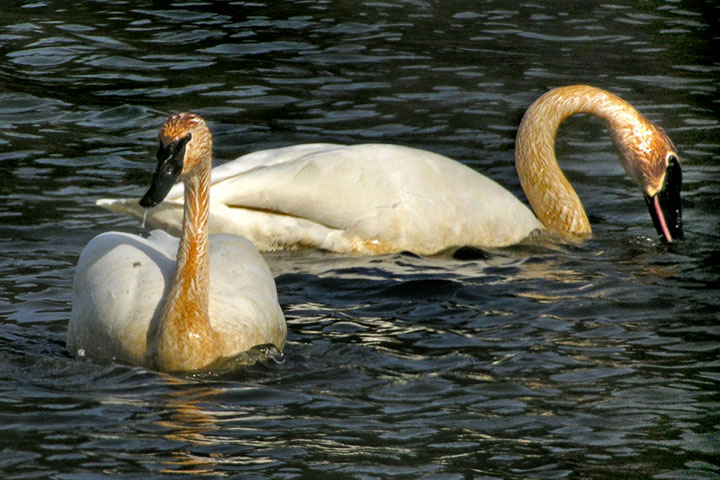 The swawn’s feathers are not always pristine white. The staining on the feathers of the head and neck is the result of foraging in iron–rich muds and waters (probably on the breeding grounds). The oxidized iron gives the feathers a rusty hue. This Trumpeter Swan couple is feeding in the shallows of the West Arm. The male, in the background is considerably larger than the female.
The swawn’s feathers are not always pristine white. The staining on the feathers of the head and neck is the result of foraging in iron–rich muds and waters (probably on the breeding grounds). The oxidized iron gives the feathers a rusty hue. This Trumpeter Swan couple is feeding in the shallows of the West Arm. The male, in the background is considerably larger than the female.
 There is one non–white shade which is characteristic a swan: juveniles have a grey neck and head.
There is one non–white shade which is characteristic a swan: juveniles have a grey neck and head.
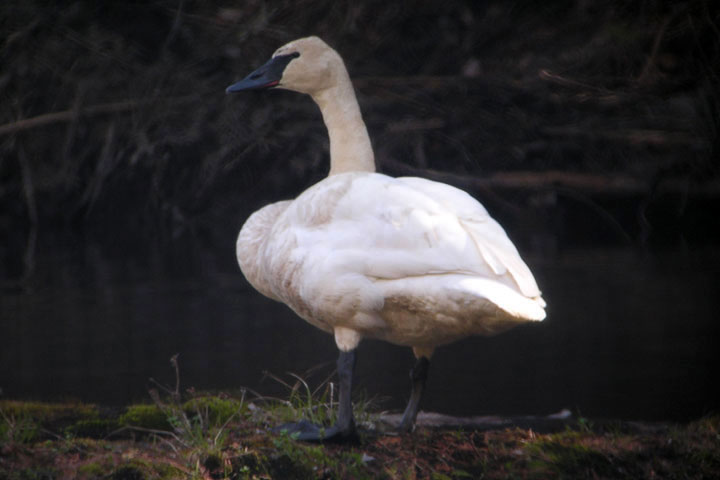 This all–white adult Trumpeter Swan was seen beside a stream at the north end of the Lake. One of the distinctive features of the Trumpeter, other than its massive bill, is the sharp angle on the crown of its head; on a Tundra Swan, the crown of the head is round.
This all–white adult Trumpeter Swan was seen beside a stream at the north end of the Lake. One of the distinctive features of the Trumpeter, other than its massive bill, is the sharp angle on the crown of its head; on a Tundra Swan, the crown of the head is round.
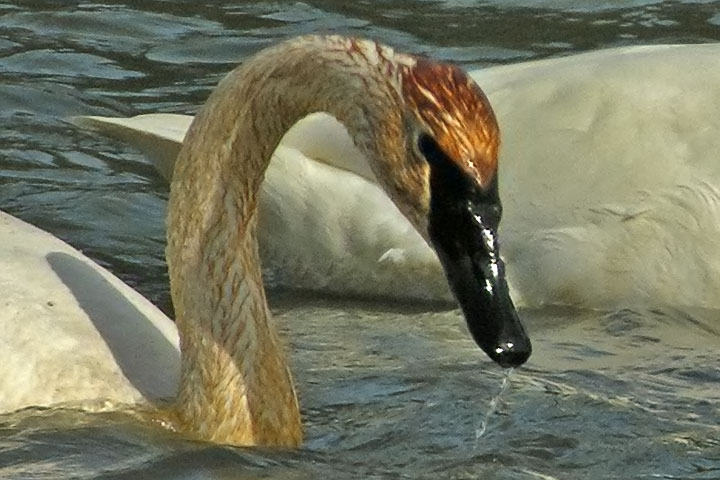 A distinguishing feature of a Trumpeter Swan is the V–shaped boundary between its forehead and beak. On Tundras, this transition is U–shaped.
A distinguishing feature of a Trumpeter Swan is the V–shaped boundary between its forehead and beak. On Tundras, this transition is U–shaped.
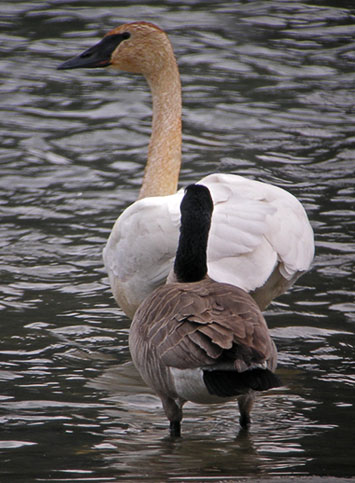 A comparison between the female Trumpeter Swan and a Canada Goose. Even though the female is the smaller of the two sexes, it towers over the Canada Goose—itself a large bird.
A comparison between the female Trumpeter Swan and a Canada Goose. Even though the female is the smaller of the two sexes, it towers over the Canada Goose—itself a large bird.
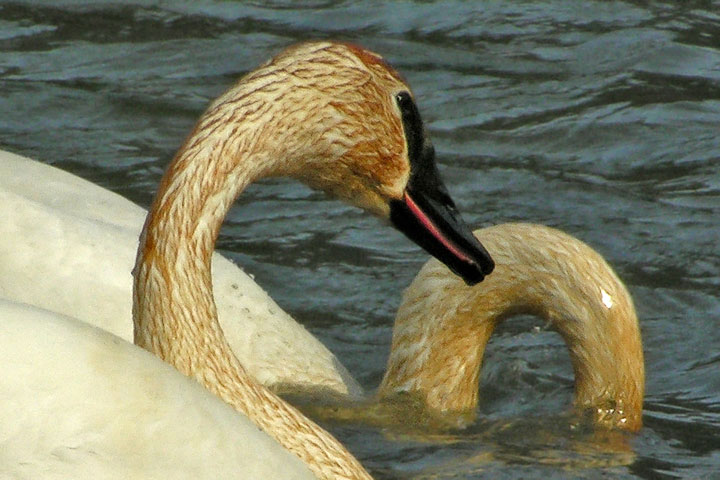 A bit of colour which appears on both the Trumpter and Tundra Swans is the reddish grin line. Not seen when the beak is tightly closed, the colouring lies along the upper edge of the lower mandible.
A bit of colour which appears on both the Trumpter and Tundra Swans is the reddish grin line. Not seen when the beak is tightly closed, the colouring lies along the upper edge of the lower mandible.
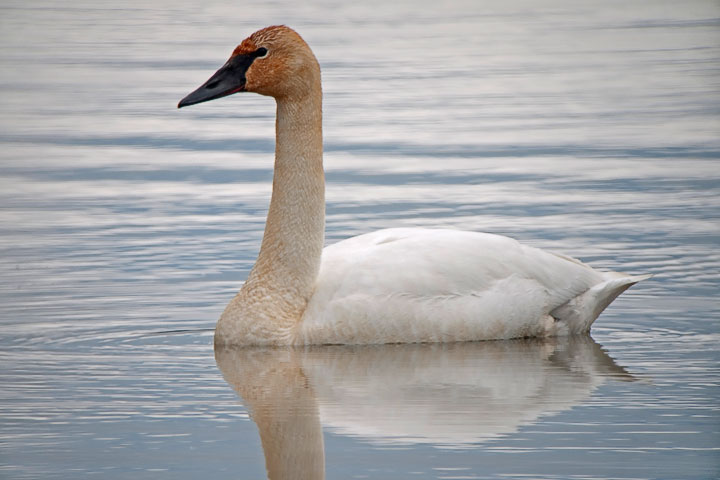 When the swan extends its neck upwards, a kink is often seen in the neck of a Trumpeter Swan. This detail is not seen in the Tundra Swans. This picture also shows the Trumpeter’s characteristic bend on the swan’s crown.
When the swan extends its neck upwards, a kink is often seen in the neck of a Trumpeter Swan. This detail is not seen in the Tundra Swans. This picture also shows the Trumpeter’s characteristic bend on the swan’s crown.
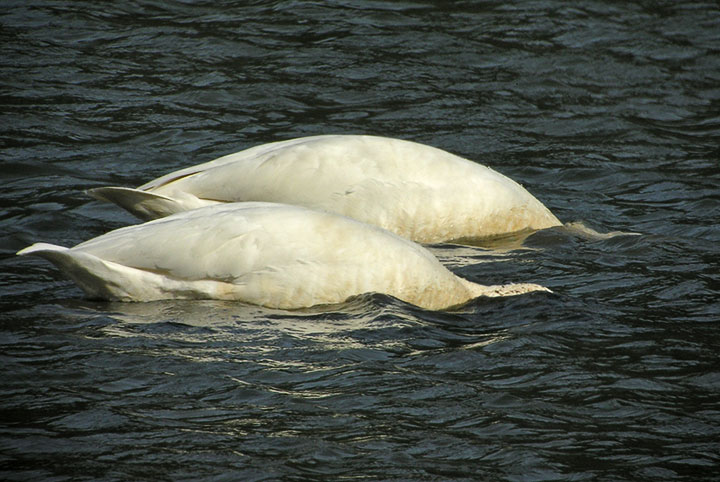 A swan’s time at the Lake is often short, much spent eating in shallows. The Trumpeter Swan has such a long neck that it can sometimes forage on the bottom even without tipping up.
A swan’s time at the Lake is often short, much spent eating in shallows. The Trumpeter Swan has such a long neck that it can sometimes forage on the bottom even without tipping up.
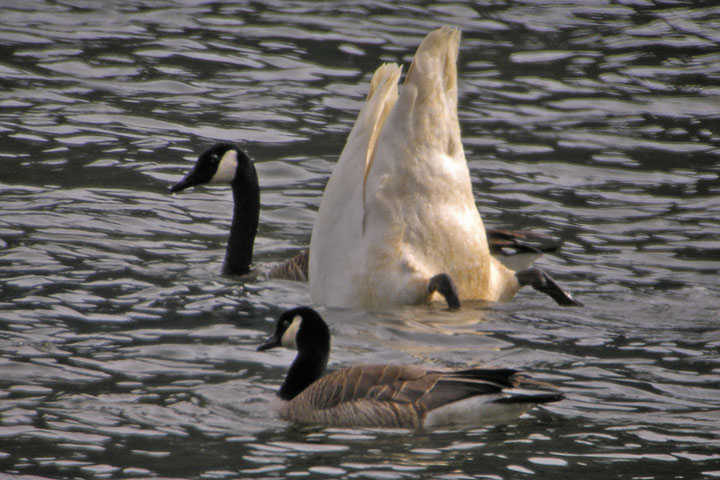 In slightly deeper water the swan tips right up—a practice of all dabblers. However, the size of the swan gives it access to the lake bottom at depths inaccessible to these geese.
In slightly deeper water the swan tips right up—a practice of all dabblers. However, the size of the swan gives it access to the lake bottom at depths inaccessible to these geese.
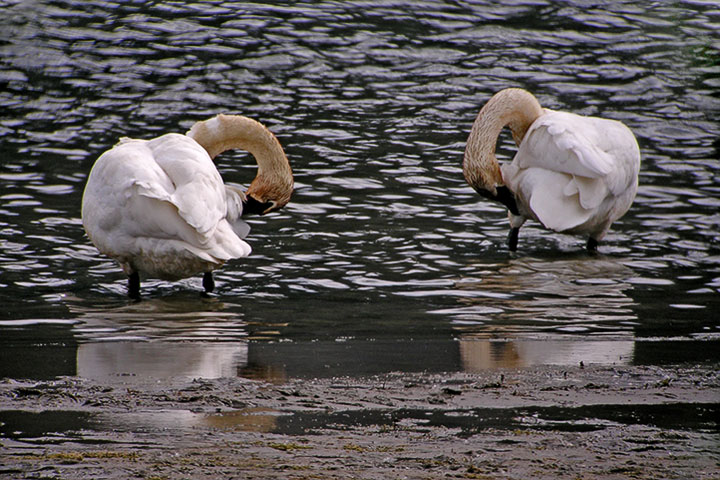 When not eating, the Trumpeter Swan spends much of its time preening—repairing its feathers for the next leg of the flight.
When not eating, the Trumpeter Swan spends much of its time preening—repairing its feathers for the next leg of the flight.
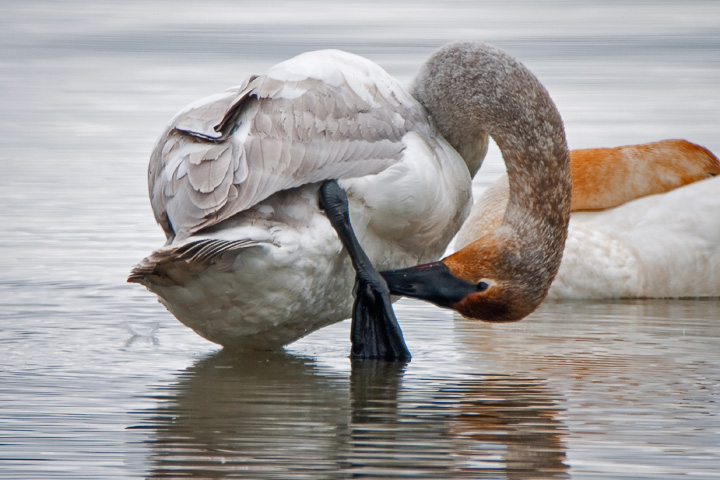 This juvenile Trumpeter is preening breast feathers.
This juvenile Trumpeter is preening breast feathers.
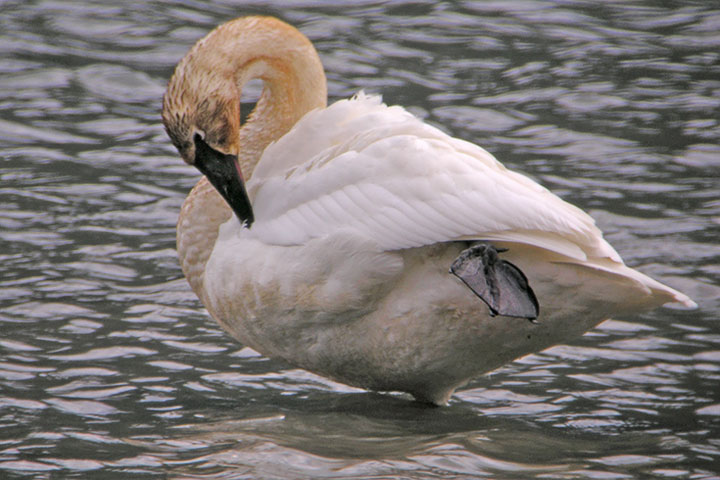 This adult male Trumpeter is also preening.
This adult male Trumpeter is also preening.
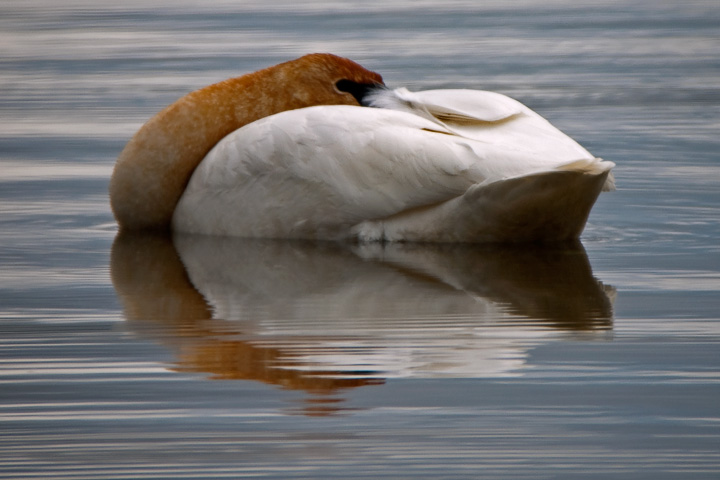 When not eating or preening, the swan rests before the next leg of the journey.
When not eating or preening, the swan rests before the next leg of the journey.
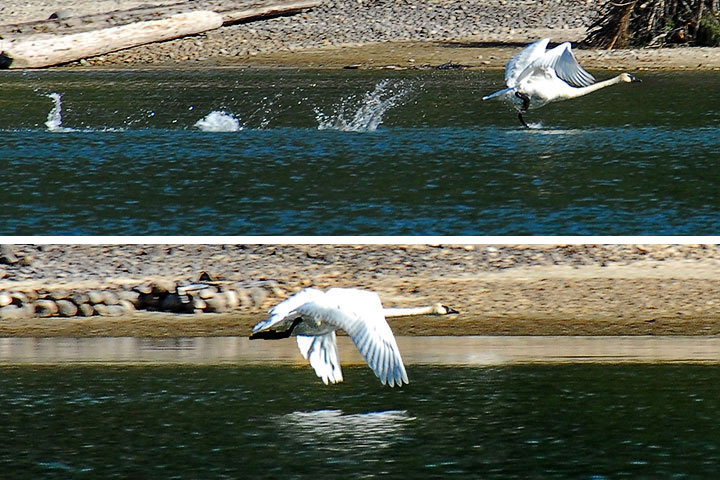 The Trumpeter Swan is the largest water bird. To get airborne, it must run across the surface of the the water. Like a cyclist, the trumpeter’s legs are pumping: in the top picture, the right foot is up and the left is down pushing against the water. Behind it are the widely spaced foot prints as it picks up speed. After a good running start across the water, it becomes airborne.
The Trumpeter Swan is the largest water bird. To get airborne, it must run across the surface of the the water. Like a cyclist, the trumpeter’s legs are pumping: in the top picture, the right foot is up and the left is down pushing against the water. Behind it are the widely spaced foot prints as it picks up speed. After a good running start across the water, it becomes airborne.
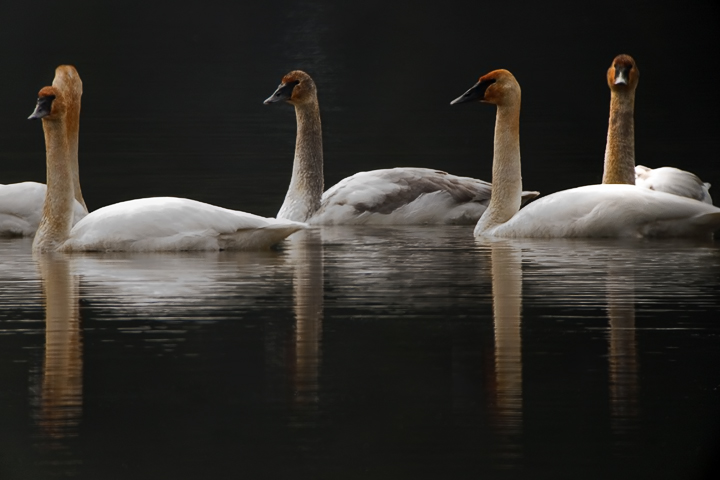 A lovely sight—if only these swans stopped by more often.
A lovely sight—if only these swans stopped by more often.
Information from Wikipedia: Trumpeter Swan.
![]()